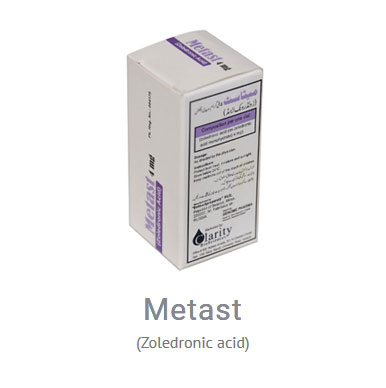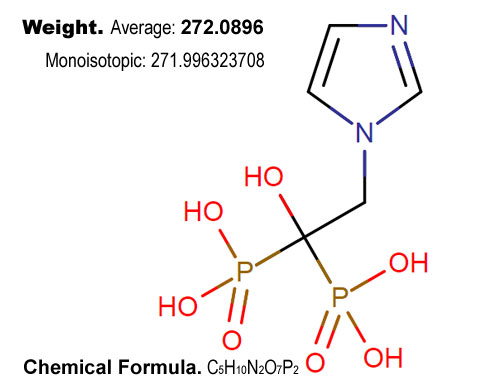
Metast
(Zoledronic acid)
Composition:
Each vial contains zoledronic acid (as zoledronic acid monohydrate) – 4 mg.
ATC Code
M05BA08 — Zoledronic acid
Structure

Description
Zoledronic acid is a bisphosphonate and used to prevent skeletal fractures in patients with cancers such as multiple myeloma and prostate cancer. It can also be used to treat hypercalcemia of malignancy and can be helpful for treating pain from bone metastases.
An annual dose of Zoledronate may also prevent recurring fractures in patients with a previous hip fracture.
Indication
- For the treatment of hypercalcemia of malignancy. Also for the treatment of patients with multiple myeloma and patients with documented bone metastases from solid tumors.
Associated Conditions
- Bone Metastases
- Hypercalcemia of Malignancy
- Osteoporosis
Pharmacodynamics
Zoledronate is a bisphosphonic acid which is an inhibitor of osteoclastic bone resorption. Zoledronate is used to prevent osteoporosis and skeletal fractures, particularly in patients with cancers such as multiple myeloma and prostate cancer. It can also be used to treat hypercalcemia, particularly hypercalcemia of malignancy. It can also be helpful for treating pain from bone metastases.
Mechanism of Action
The action of zoledronate on bone tissue is based partly on its affinity for hydroxyapatite, which is part of the mineral matrix of bone. Zoledronate also targets farnesyl pyrophosphate (FPP) synthase. Nitrogen-containing bisphosphonates such as zoledronate appear to act as analogues of isoprenoid diphosphate lipids, thereby inhibiting FPP synthase, an enzyme in the mevalonate pathway. Inhibition of this enzyme in osteoclasts prevents the biosynthesis of isoprenoid lipids (FPP and GGPP) that are essential for the post-translational farnesylation and geranylgeranylation of small GTPase signalling proteins. This activity inhibits osteoclast activity and reduces bone resorption and turnover. In postmenopausal women, it reduces the elevated rate of bone turnover, leading to, on average, a net gain in bone mass.
Product Information
Share This Story, Choose Your Platform!
